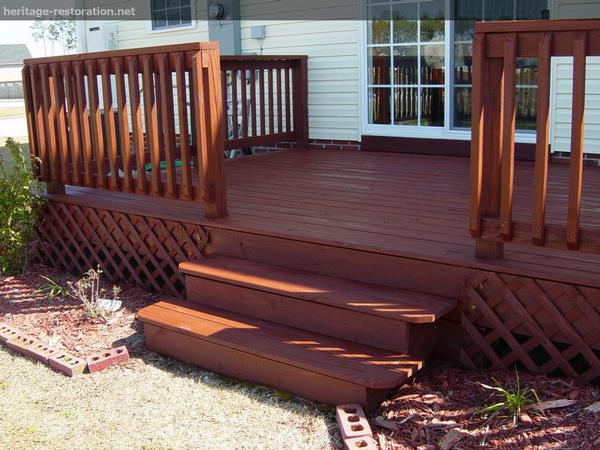Last Updated on August 1, 2024 by teamobn
Now that you’re done constructing your deck the only thing left to do is to add the finishing touches. Both oils and stains have their own distinct advantages. In this post we’ll have a look at both finishing materials.

Finishing your deck with an oil or stain is an important step to ensure that your deck will last for years. Untreated wood is vulnerable to cracking, fading, and weathering and attack by fungus and other microbes. Treated timber will also dry and crack over time but will not rot assuming the treatment has been performed properly. Regular application of an oil or stain ensures that decking materials are well protected against the major causes of deterioration.
Decking Oil
Decking oil is used to protect wood from weathering and UV exposure. Because it soaks into the timber, restoring lost natural oils it significantly reduces the risk of decay. The right oil also greatly enhances the appearance of the deck.
Choosing the right colour
Decking oils vary in terms of colour. Tinted oils provides a richer and darker tone to the wood and are best for lighter shaded wood. Natural (untinted) oils retains the original colour of the wood. Wood valued for its colour is best finished using clear oils because it highlights the deep and rich natural colour of the wood.
Note that you should apply the first coat of oil as soon as practicable after completion. Delaying, even for a few weeks, will cause some permanent discolouration and bleaching of your timbers.
Decking oil application
The method of application depends upon the variety of wood and the type of oil you’re using. In recent years, despite sounding counter-intuitive, some excellent water-based oils have become available. They are very easy to apply and give an excellent finish however, in my experience, need re-coating more frequently than traditional oils. The trade-off is that they are quick to apply so your annual time commitment is probably equal.

To get the best results with any oil (or stain) it’s best to experiment by applying the oil on an off-cut from the job to see what the finished effect will be. If you have used a combination of timbers, for example, pine and cedar, make sure you test the oil on both as they will give very different results. You may need to add a tint to the pine and use a clear finish on the cedar.
Go lightly, my friend…
Avoid applying thick coats of oil as the excess oil can attract dust and other particulates. Instead, apply a light coat wait between a week or even a fortnight between coats. This will give the oil time to soak completely into the wood before you apply additional coats.
Wood stains
Much like decking oil, wood stains also protect wood from weathering, UV rays, and other forms of deterioration. Unlike an oil, stains seal the wood, adding an extra layer of protection against the elements. It is important to understand the difference because you cannot ‘unstain’ timber.
Wood stains are used to permanently alter the colour of the wood. Stains come in a wide variety of penetrating strengths. These strengths allow you to control the depth of colour and tint of the wood.
Wood stain variation
The ability of the stain to penetrate determines the kind of pigmentation it’s able to create. Less penetrating stains provides a solid stain. Less penetrating stains provide the best UV protection but because they don’t penetrate well they fade easily. Deep penetrating stain provides transparent or semi-transparent finish. Deep penetrating stains provide less protection against UV rays but are able to highlight the natural grain and character of timber.

Wood stain maintenance
Maintaining a wood-stained deck is crucial for preserving its appearance and extending its lifespan. While it does require resealing, the frequency and intensity of maintenance are generally less demanding compared to decks finished with oil. This is largely because stains provide a more durable layer of protection against the elements.
Despite this durability, constant exposure to sunlight, rain, and temperature fluctuations can degrade the stain over time. If not maintained properly, the deck can start to look worn and unattractive. It’s important to perform regular inspections and touch-ups to keep the surface looking fresh and vibrant.
Scheduled maintenance, including cleaning and reapplying a top coat of stain, will not only improve the appearance of your deck but also protect it from moisture and UV damage. By keeping up with these maintenance tasks, you also reduce the amount of preparation needed when it’s time to re-stain the deck. Thoroughly cleaning the deck and applying a fresh coat of stain at recommended intervals ensures that the wood remains sealed and protected, thus minimizing the labor-intensive stripping and sanding that might otherwise be required.
Wood stain application
As with decking oil, it’s best to apply a couple of coats to off-cuts or excess pieces of wood to test the final look of the stain. You should also avoid rebrushing stain that has already been applied as this will often result in annoying changes in colour depth in that spot. Instead, work consistently in one direction. You should also stain the entire area in one sitting as this will give full colour consistency.
So, there you go! Both oil and stain have distinct advantages. For me, the decision usually comes down to the quality of timber used. If the deck is merbau, teak or jarrah for example, I will want to highlight and enhance the natural beauty of those timbers by using a clear oil. If the deck is pine, I will usually choose a solid colour stain in order to get colour consistency and to provide maximum protection.
Now it’s over to you… oil or stain? Which one will you use and why?
Preparation Techniques for Deck Finishing
Any great outdoor decking project starts with proper preparation. Whether you are applying oil or a fresh coat of stain, the basic preparation done before the first brushstroke greatly affects the lifetime and look of the finish. Here’s how you make sure your outdoor platform is ready for completing.
Assess the Condition of the Wood
First, carefully go over the wood looking for any damage—including rot, fractures, or splinters. Replace broken planks to keep your decking area looking and structurally sound. This stage is absolutely important since it guarantees longer lifetime and good adherence of the final result.
Clean Thoroughly
Eliminate from the surface all trash, dirt, and past finishes. Though used cautiously to prevent damaging the wood fibers, a power washer can be quite effective. A stiff brush and a deck cleaning solution fit for your wood type will help with less forceful cleaning. Usually depending on the temperature, let the surface dry totally; this takes 24 to 48 hours.
Sand the Surface
Sanding smooths off rough areas, evens out places where old finishes could have peeled off, and opens the wood’s pores to improve the new finish’s absorption. Always sand in the direction of the wood grain to avoid scratches that can compromise the surface using a medium to fine-grit sandpaper. For a perfect basis on which to apply the finish, clean the sawdust after sanding with a brush or leaf blower.
Check Moisture Content
See the wood’s moisture level before applying any finish. The best absorption and adherence of the stain or oil depend on the appropriate moisture content being less than 15%. For this, one can make advantage of a basic moisture meter. Applying finish to damp wood can trap moisture, therefore promoting mildew development and a reduced lifetime of the finish.
Apply a Wood Brightener
Although they are not required, wood brighteners help to restore the original color of the wood and eliminate any grayish tint brought on by sun exposure, therefore improving its natural beauty. They also neutralize any cleanser residue, which can compromise the oil’s or stain’s performance. Apply according to manufacturer’s directions; let it completely dry.
Mask Non-Deck Areas
Particularly if you are working near plants, walls, or furniture, protect areas surrounding your decking with tape and plastic sheeting. This helps to avoid inadvertent stains from drips and splatters, which once dried can be challenging to remove.
Select the Right Tools
Select the instruments that would most fit your intended finish. Though each has benefits based on the type of finish and the complexities of the deck’s construction, brushes, rollers, or pads are all appropriate. While pads could be better for even applications of stain, brushes assist get into the grooves of the wood and perform well for oil-based finishes.
Carefully cleaning your outdoor space guarantees that the finishing procedure not only improves its appearance but also safeguards it for many years to come. Both the short-term look and long-term durability of your outdoor living space benefit from this first investment of work.
Conclusion
Choosing between oil and wood stains for a deck hinges on your priorities. Oils penetrate deeply to nourish wood and offer natural beauty, making them ideal for high-quality timber that you want to showcase. In contrast, stains provide a protective seal and more color options, perfect for achieving uniformity and enduring harsh weather conditions.
If you have any questions or you’d like to share your experience, just scroll down to the comments box below. Thanks for joining me.
In our last post in this series, I discuss the why Free-Standing Desks are Such a Great Alternative…








